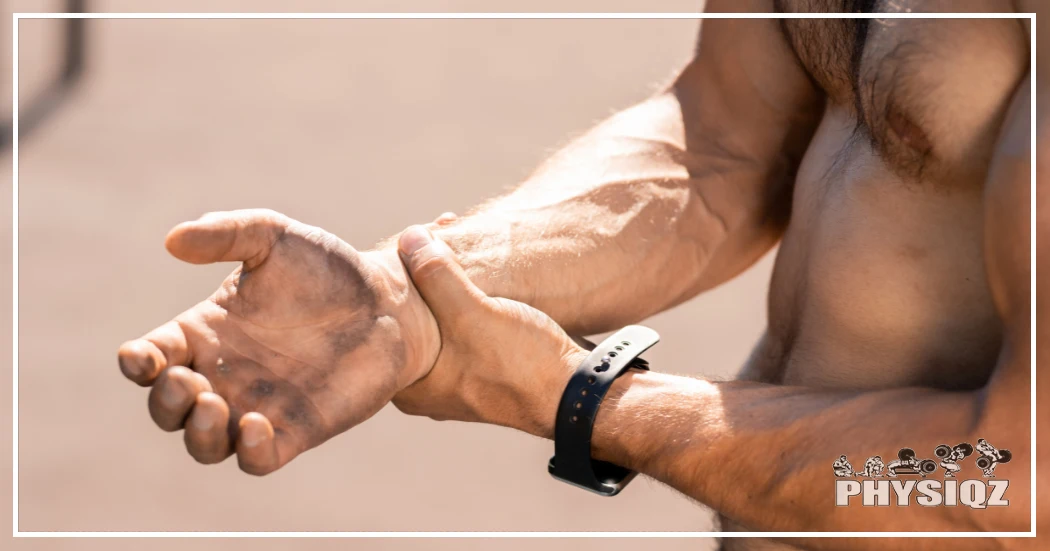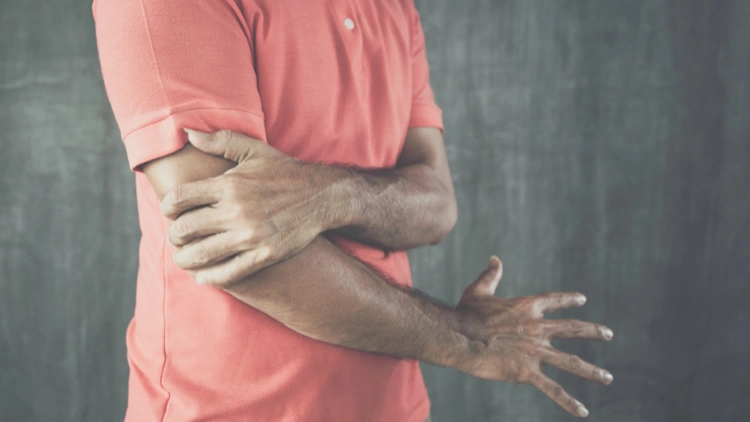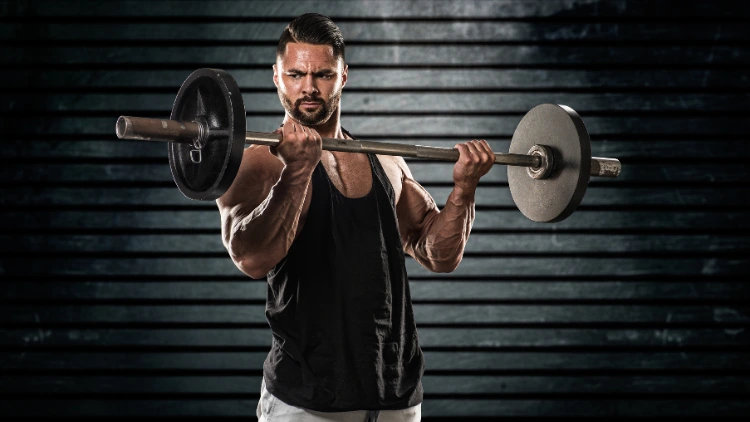
Many gym enthusiasts around the world experience forearm pain during curls. This discomfort can arise for several reasons. It’s important to understand the causes of this pain, determine if there’s cause for concern, and learn the best methods to alleviate it.1
To begin with, it’s crucial to distinct if the pain originates from the forearm or elbow because the causes and cure are different for each. On the extreme end, interventions such as NSAIDs, injections and surgery are options.
But in most case, elbow and forearm pain can be resolved by changing technique, the type of bar used, or trying things like warming up, wrist wraps, other forms of therapy, and the tricep exercise cure which is our go-to.
Why Do My Forearms Hurt When I Curl: Top Reasons Why
The forearm hurts for several reasons when an individual is curling and is a cause for concern among many, especially when the problem is chronic; this often leaves lifters wondering about the cause of their forearm pain during curls.
The pain is a result of tendonitis—which is inflammation of the tendons (connective tissues similar to a cord or rope containing strong collagen fibers that bridge the forearm muscles with radius and ulna—tendinopathy symptoms will include pain, swelling, and stiffness.2
The top reasons why the forearm pains include bearing the weight that is too heavy, incorrect elbow positioning when curling, or not maintaining constant tension when curling.
Heavy Weight
When a lifter is curling weight that is too heavy than the biceps or the forearm muscles can bear, the load will be transferred to the tendons. This will result in inflammation setting in the tendons and forearm muscles resulting in pain.
Clinching the bar too tightly can also cause inflammation. Excessive repetition even with lighter weight could lead to tendonitis.
Improper Elbow Positioning
The forearm muscles are not actively recruited during a curl but their use is maintained since the forearm is the link between the bicep muscle and the wrist holding the weight.
During a curl, the flexor muscles develop tension but not due to contraction; improper elbow positioning will lead to unnecessary contraction resulting in inflammation and subsequent pain. In this case, the tendons are at a mechanical disadvantage during the curl.
Tight Forearms
Curling with forearm muscles that are tight and therefore stiff will cause them to be stressed due to being rigid. The brain interprets this tightness as pain and in some cases nerves can be compressed which can cause a shooting pain during the curl.
Not Warming Up
When the muscles are not warmed up, they are not prepared for aerobic activity. The cardiovascular system is not revved up and there is decreased blood flow to the muscles. Working out in this state may lead to muscle soreness (pain) and increase the risk of injury.
Lack of Constant Tension
When a lifter is curling weights and fails to place constant tension by controlling the movement it results in jerking around or doing the curls too quickly. All this will place stress on the tendons in the forearm which will lead to pain disrupting other workout routines.
Using the Same Forms of Biceps Curl
When lifters use the same method of biceps curls without adding variations, they will be setting themselves up for injuries as a result of overuse. Changing the technique will alter the forces on the forearm limiting overuse to certain sections of the forearm.
Infection
While rare, there may be an infection in the blood vessels—this condition is known as thrombophlebitis. In some other instances, the skin over the forearm can be infected making the forearm writhe in pain. There may be fluid buildup in the elbow that can also cause pain in the forearm.
Forearm Pain vs Elbow Pain From Curls

Source: Anut21ng via Canva.com3
There is a clear distinction between forearm pain as well as elbow pain that is experienced when doing curls. Elbow pain is a result of microscopic tears and inflammation of the tendons located at the lateral epicondyle and medial epicondyle—the bony bumps on the outer and inner side of the elbow.4
Commonly known as tennis elbow and in some cases golfers’ elbow—these usually occur when the forearm muscles are not accustomed to a certain activity such as repetitive wrist twisting and elbow bending. The pain originates outside the elbow and may run down the forearm and pain is felt when gripping objects or twisting the forearm.
Elbow joint tendinitis causes pain to emanate from the front of the tricep muscle where it is attached to the elbow.
Tendinopathy that causes the forearm to hurt will result in pain running laterally (from one side to the other) at the center of the forearm near the locale of the radius bone (the radius bone runs from the thumb side of the arm to the elbow) next to the wrist joint or at the pronator teres—soft tissue at the opposite end of the same bone at the elbow joint.
This is in contrast to injuries caused by curling including bicep tendinopathy where pain diverges from the biceps brachii (denoting the bicep’s two-headed anatomy of short and long head) lower attachment at the elbow.
Therefore, the two differ because elbow pain is caused by the tendons at the elbow joint that connect them to the muscles whereas forearm pain is the surface, deep muscles, and tendons of the forearm that are inflamed.
How to Cure Elbow Pain Caused From Curls
The most effective cure for elbow pain caused by curls is to rest the arm and cease curling to allow the inflammation to heal. For minor elbow pain, it will heal without treatment in a time ranging from 6 to 24 months for those experiencing forearm pain while curling.
- PRICE and RICE—an acronym for protection, rest, ice, compress, and ice. In addition to taking time off and speeding up the healing process, applying cold to the elbow for a few minutes daily can cure elbow pain, and use a brace for protection to support the elbow.
- NSAIDS—non-steroidal anti-inflammatory drugs (NSAIDS) such as ibuprofen or painkillers like paracetamol will help reduce the inflammation.5 They can be topical or ingested as tablets.
- Steroids—in some cases, steroids injections containing cortisol are administered to the area around the elbow but these only provide short-term relief and are ineffective for the long term.
- Shockwave therapy—shockwaves can target the area of concern and may provide relief and healing. Shockwave therapy is non-invasive and can be a catalyst to regenerate inflamed tissue.6
- Physiotherapy—physical therapy techniques such as massage may be used to stimulate blood flow to the affected areas. Physiotherapists will demonstrate exercises to stretch and strengthen forearm muscles.
- PRP injections— platelet-rich plasma injections may be administered; this is blood plasma rich in concentrated platelets that are used by the body to promote healing in the affected area. Donating plasma does not affect muscle growth, but be aware of the potential risks of fatigue and injury.
- Surgery— depending on how severe the elbow pain is, surgery may be the last resort to remove the injured section of the tendon that is acute and persistent.
How To Fix Forearm Pain When Curling
It is surprisingly simple to fix pain in the forearm when curling, and those experiencing discomfort in their forearm during curls can employ several techniques to address their concerns.
These include avoiding tucking in elbows when curling, warming up and stretching the forearms, or using the appropriate weight when curling.
Keep a Flat or Neutral Wrist Position
Keeping the wrist neutral and flat during curling by facing the palms in rather than up will enable the bicep to move in its full range of motion encouraging hypertrophy. This action is known as supinating the wrists—bending the wrists forward will stimulate the flexor tendons connected to the inner section of the elbow causing pain; conversely bending them back will stimulate the tendons that attach the outer elbow to the wrist leading to pain in the outer elbow.
Avoid Tucking Your Elbows
The elbows need to be kept to the side of the torso and lifters would need to avoid tucking them in. because this will recruit the forearm flexors more than is necessary taking away from the biceps. Keeping them on the side will allow them to be positioned in front of the weight’s center of gravity—this will help limit the tension around the biceps before they curl up.
Replace Barbell Curls or Preacher Curls With an EZ Bar Curl

Source: EXTREME-PHOTOGRAPHER via Canva.com7
Replacing barbell curls and preacher curls with EZ bar curls is beneficial because these bars allow the lifter to curl with a semi-supinated grip putting less stress on the wrists and subsequently the forearms. The downside is the biceps are recruited less than with barbell curls.
Try Pronated Curls (Overhand) Instead of Supinated (Underhand) Curls
The bicep is composed of two muscle heads; the outer part which is the long head and the short head which is the inner part. Pronated curls will work the outer head and the brachialis (located below the biceps brachii). These curls target the forearms and will help develop grip strength—weak forearms could be a source of pain.
Drop the Weight & Increase Reps
When lifting heavy weights, the forearms will need to work extra hard to stabilize the weight during the curl which will lead to pain. The lifter should drop the weight and increase reps which will gradually develop forearm and bicep strength.
Warm Up &/or Stretch Your Forearms (Rare Reason for Forearm Pain During Curls)
Warming up the forearms will increase blood flow and temperature to prepare for curling. This can be done with light weight; ranging from 5-10 pounds in a set of 10 reps. Stretching the forearms will ensure that curls can be done in a full range of motion, reducing tension in the biceps and allowing them to work effectively.
Focus on Relaxing Your Forearms While Curling
It is imperative to focus on relaxing the forearms when curling, as mentioned before they are not the main source of contraction in the curl—the biceps are. When a lifter tenses them, this will cause them to get activated taking the load off the biceps that are the primary movers. The forearm extensors are stimulated isometrically and they don’t get enough tension during curls.
Get a Pair of Wrist Wraps
The goal is to keep the wrist as neutral as possible during curling and a pair of wrist wraps will provide the wrists with support and add to rigidity helping to stabilize the wrists. This will translate into less stress on the wrist joint and forearm and reduce the pain caused by a compromised form. Inzer gripper wrist wraps are an ideal brand and are available in 20 and 36 inches.
Lifters may also use this tricep exercise to alleviate elbow joint tendonitis as the tricep is an antagonist muscle to the bicep. Cable overhead triceps extensions and tricep pull-downs will strengthen the tricep muscles placing less stress on the tendon that connects it to the elbow—eliminating elbow pain.
How Do I Alleviate The Pain If My Forearm Hurts Days After Lifting?
If the symptoms of forearm pain still persist, then someone can include other methods to alleviate the pain—especially if recovery from lifting has not caused pain to subside.
- Ice—as with elbow pain, ice may be used to provide relief right after an injury. Ice will address the inflammation caused by the injury by reducing the blood flow to the area thus limiting its onset.8 It is however not a long-term solution. It can be applied for 15 minutes up to 6 times a day in the first 48 hours.
- Rest—taking time off the gym is beneficial as it will give the injury time to heal as it may be aggravated by continuously working it, especially with other exercises. Forearm injuries are graded 1 through 3. Grade 1 which are mild injuries will take 7-14 days to heal; the forearm doesn’t lose strength. The lifter may concentrate on the lower body to maintain fitness.
- NSAIDS—as mentioned before, NSAIDS like ibuprofen could help reduce inflammation in the forearm and thus reduce pain. NSAIDS should ideally be used only if necessary and as a last resort due to a myriad of different side effects and issues that may arise from their use.
- Stretching— this will help reduce tension on both the forearms and muscles and increase mobility allowing them to work more efficiently.
- Myofascial release—individuals may use a lacrosse ball to find pain points and apply pressure to release tension that has been built up. When a tight trigger spot has been located, time should be spent on that area by applying some extra pressure. My ofascial release does have a positive impact on alleviating pain.9
Lifters should no longer stop and ask themselves why their forearm hurts when they curl but should proactively address the pain to allow them to not be inhibited in enjoying their weightlifting programs.
References
1shironosov. “Hurt wrist.” Canva. Accessed 11 April 2023. <https://www.canva.com/photos/MADmq-QRtwM-hurt-wrist/>
2Channel, B. H. (2022). Tendinopathy (Tendonitis). Retrieved 2022, from <https://www.betterhealth.vic.gov.au/health/conditionsandtreatments/tendonitis>
3Anut21ng. “elbow pain at arm.” Canva. Accessed 11 April 2023. <https://www.canva.com/photos/MAEE6hr-gus-elbow-pain-at-arm/>
4Channel, B. H. (2022). Elbow pain. Retrieved 2022, from <https://www.betterhealth.vic.gov.au/health/conditionsandtreatments/elbow-pain>
5Administration, U. F. (2022). Nonsteroidal Anti-inflammatory Drugs (NSAIDs). Retrieved 2022, from <https://www.fda.gov/drugs/postmarket-drug-safety-information-patients-and-providers/nonsteroidal-anti-inflammatory-drugs-nsaids>
6Medicine, N. L. (2020, February 12). Extracorporeal shock wave therapy mechanisms in musculoskeletal regenerative medicine. Retrieved from <https://www.ncbi.nlm.nih.gov/pmc/articles/PMC7275282/>
7EXTREME-PHOTOGRAPHER. “Bodybuilder Barbell Curls.” Canva. Accessed 11 April 2023. <https://www.canva.com/photos/MAEEVuwPb0w-bodybuilding-barbell-curls/>
8Medicine, N. L. (2013, March). Topical Menthol, Ice, Peripheral Blood Flow, and Perceived Discomfort. Retrieved 2022, from <https://www.ncbi.nlm.nih.gov/pmc/articles/PMC3600924/>
9Medicine, N. L. (2014, June 13). Effectiveness of myofascial release: systematic review of randomized controlled trials. Retrieved 2022, from <https://www.ncbi.nlm.nih.gov/pmc/articles/PMC3600924/ https://pubmed.ncbi.nlm.nih.gov/25603749/>